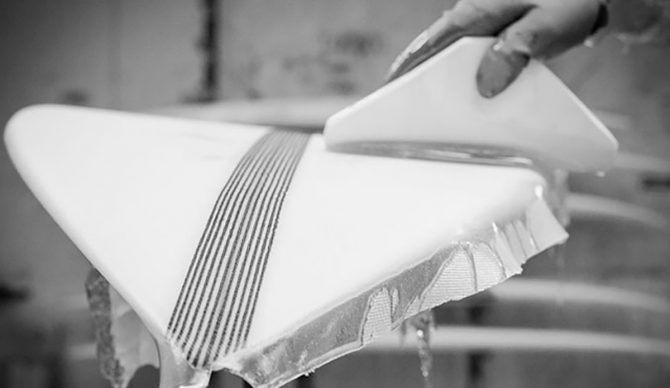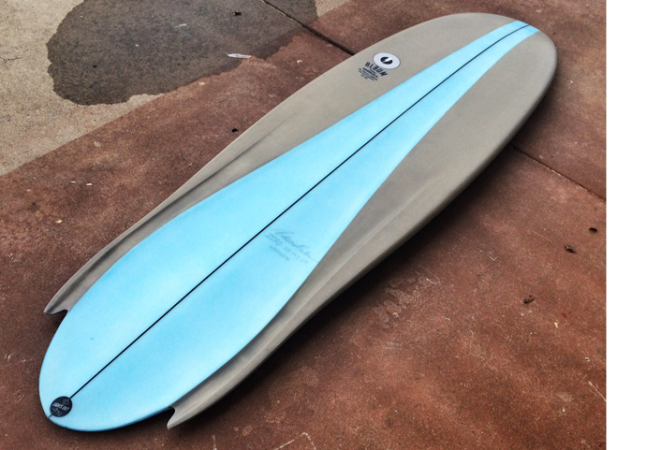
Glassing is one of the final steps. But the contours are made as the board is shaped.
Editor’s Note: Welcome to our new series, “By Design” with Sam George that examines the genius, and sometimes the mystery, of surfing’s storied design history. Sam has been writing about surfing for more than three decades and is the former Editor-in-Chief of SURFER magazine. He won an Emmy for his work on the 30 for 30 documentary, Hawaiian: The Legend of Eddie Aikau. Today, Sam looks at the function of surfboard bottom contours.
Today’s surfboard buyers are probably the most well informed in the history of the sport, considering the list of dimensions either hand written on the stringer or foam, or included in a laminate sticker. Nose, center, tail width and volume – most avid surfers can recite their numbers by rote. They’re quantifiable, simple to understand and easy to point to in terms of impact on performance. Not so with one of the most crucial aspects of surfboard design: bottom contour. Even experienced shapers sometimes have trouble explaining why they do what they do to the bottom of your surfboard. Yet while subtle in appearance, bottom contours play a big part on how your particular board works. So consider this a primer, to both help you better understand that board under your feet, and/or make a more informed purchase the next time around.
Two essential hydrodynamic terms: planing hull and displacement hull. Put simply, a planing hull moves across the surface of the water, while a displacement hull, partially submerged, displaces water as it moves through the medium. The planing craft, by creating less drag, is very fast but difficult to control, especially standing up. Displacement craft, slower but more stable, afford a smooth, more controlled ride. Got it? Let’s move on.

Concave on an Album board.
Concaves
We’ll start with concaves, as they were the first significant deliberate modification of the surfboard’s bottom contour. Especially impactful were those incorporated in the 1940s by the über-inventive Bob Simmons, who, obsessed with more sophisticated hydrodynamic principles than were currently in use, began experimenting with the design. Simmons’ goal was pure velocity, which the concave provided…and still does on modern surfboards. Here’s why: As a planing hull moves, water flows outward and off the hull, reducing efficiency. But as water flowing across the hull enters the forward part of a concavity and moves toward the board’s narrower tail that water is compressed. Downward pressure from this compressed flow against the upward pressure generated by the surrounding water raises the hull (the good ‘ol Bernoulli’s Principle again) thus reducing drag. In short, concaves generate lift, which increases speed. A secondary effect occurs when turning, as a concave hull, when rolled over into a turn, reduces wetted surface area, increasing speed throughout the maneuver.
Vee
This one’s easy: Vee bottoms facilitate easier, smoother rail-to-rail transitions. The first vees, as imagined by innovative Australian surfer/shapers Midget Farrelly and Bob McTavish back in 1967, were pretty easy to understand. These early “panel vees” were just that: twin panels of a flat planing surface peaking at the stringer in dramatic fashion, intended to allow the board to be banked over into a turn rather than rolled. Ok, they were also slow and hard to control, but it was a good start. The use of vee became more sophisticated during the early-to-mid ‘70s, when shapers like Dick Brewer and Terry Fitzgerald began incorporating more subtle vees that when weighted in a turn directed water flow into double concaves along the rail. This pairing of the vee’s rail-to-rail turning advantages with the concave’s lift/speed component turned out to be a winning combination, with a modern incarnation applied in some variation on most of today’s “high-performance” surfboards. Exceptions include certain small-wave models like the Channel Islands “Free Scrubber” twin fin, which features a retro straight-vee bottom and the DHD 3DV, which utilizes only a very sight vee running off the tail. But regardless of the design, any thoughtful application of the vee-bottom will help your board turn easier.

Using a squeegee to smooth excess resin out of the channels. Photo: WS
Channels
Channels differ from concaves in that along with creating some lift, they actually serve two significant functions. One is the manner in which they compress water flow across the bottom of the board toward the tail more directly, providing what channel aficionados describe as “thrust’ throughout the turn, especially in faster, hollower waves. More quantifiable, however, is the effect of cutting channels through the existing tail rocker. By reducing bottom surface area in a board with increased tail rocker, you combine the turning characteristics that the slower rocker provides with the lift that the channels generate, the result being a board that turns with less loss of speed. This is the ‘drive’ that many channel-bottom lovers point to. Downsides: The reduced area in the tail tends to see the board sinking in smaller, less powerful waves, and in choppy conditions channels tend to funnel air into the water flow, creating turbulence that offsets their advantages.
Displacement Hull
Definitely a niche design, the ‘hull’, as envisioned by shapers like the iconic Greg Liddle, NorCal’s Marc Andreini, the late Scott Anderson and Ventura’s Klaus Jones, is definitely one of the most misunderstood surfboard models out there. Despite their wide, continuously curved outline, these are not ‘fun boards” – in fact, except in the optimum conditions they can be difficult to ride. With their rounded bottoms they don’t ride across the top of the water, but through it, displacing it as they go. This makes them slower, but more stable, which is great…until you try to turn. Then the displacement creates a ‘hole’ into which the tail sinks. Combined with the pinched, low-volume rail created by the boards convex profile, the buoyancy necessary for a controlled turn is reduced, making on-rail turns tricky, to say the least. This explains why these boards are meant to be ridden well forward of the tail section, banking from rail-to-rail rather than driving off the fin. In addition, the flat-out speed that hull-lovers crave can only be achieved in very limited circumstances: long, fast, lined-up waves where the lift afforded by entry rocker alone raises the hull up onto its apex, reducing wetted surface area. Think head-high Malibu, Rincon, Scorpion Bay or Noosa Heads – with nobody in your way. Yeah, good luck.

